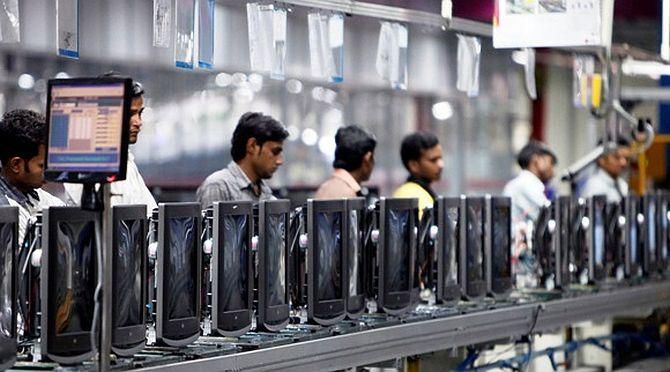'India has the potential to reduce its trade deficit with China by $8.4 billion in FY21.'

On Thursday, July 23, the government imposed restrictions on public procurement from China and other countries with a common border.
As the military stand-off in Ladakh continues, the Modi government accelerates its campaign to curb the Chinese influence on the Indian economy.
Sankar Chakraborti, Group CEO, Acuité Ratings & Research, tells Rediff.com's Prasanna D Zore about do-able steps that can help India cut back its imports from China.
What are India's biggest imports from and exports to China? How does India fare in comparison to China in global trade?
China being an export-driven economy is one of the largest players in global trade with exports of $2.5 trillion and imports of $2.1 trillion in CY19 (calendar year).
China's trade surplus was pegged at $422 billion in CY19 while India's trade deficit was at $160.5 billion in FY20 (financial year).
With exports and imports combined, India's trade volumes are only a modest 17 per cent of that of China.
However, Acuité Ratings & Research in its recent report stated that India has the potential to reduce its trade deficit with China by $8.4 billion in FY21, which is equivalent to 17.3 per cent of the deficit with China and 0.3 per cent of India's GDP.
This can be achieved by the rationalisation of just a quarter of India's imports from China in select sectors where the domestic economy has well-developed manufacturing capabilities.
How do you look at the India-China stand-off in Ladakh vis-a-vis an opportunity to scale down imports from China? By how much can we reduce our imports from China?
India is rich with human capital and desires to be self-sufficient in every possible segment. But the Indian economy will need many years of calibrated approach to reduce dependency on other countries.
We believe that there exist almost 40 sub-sectors, which can absorb imports from China significantly.
Cumulatively, these sectors see imports of $33.6 billion from China on an annual basis.
We determine that in the first phase, these sectors can reduce imports to the tune of $8.4 billion within a fiscal depending on the prevailing economic climate.
These are short-term and can be accomplished given the availability of resources.
However, ease of doing business, particularly in the manufacturing sector, and the financial sector's ability to assess and take risks will play the most important role in garnering a significant share of the expanding markets in the long run.
In FY20 India had a $48.5 billion trade deficit with China? How can India bring down this huge number by half or even say one-fourth?
Under normal circumstances, it is not advisable to have a complete embargo on imports.
This is because a healthy economy must have access to the finest quality goods and services at the best available price point.
Therefore, in a free market, countries compete based on what they can do best as compared to their peers.
Having said that, for countries such as India, it is wise to specialise and find strengths within the domestic economy.
Based on Acuité's assessment, with a conducive policy framework and a focused approach, India can very well substitute nearly 50 per cent of its imports from China.
A quarter of such imports can be absorbed by domestic enterprises with minimal additional investment in capacity creation.
What are the sectors/industries that can play a big role in reducing India's import bill with China?
Sectors that can potentially act as a buffer in the initial phase include chemicals, automotive components, bicycle parts, agro-based items and related commodities, handicrafts, drug formulations, cosmetics, consumer electronics, and leather-based goods.
Some of these sectors comprise of multi-billion enterprises or super-specialised MSMEs that can easily take over and become effective import substitution tools for India.
Does India have the manufacturing capacity as well as a robust supply chain to substitute these imports from China and will we be able to produce them cost-effectively?
The recommended sectors possess the wherewithal to successfully safeguard interests and reduce India's dependency on China. Acuité Ratings and Research believes that with the right strategic environment, economies of scale and best business practices will eventually lead to a robust supply chain.
What cost will India have to pay in terms of our GDP growth if we bring down imports from China to half or one-fourth of existing trade?
It is all about efficiencies achieved via better value substitutes sourced abroad or locally.
We are aware that India's imports from China are mostly finished and high-value intermediate goods.
Consequently, if the Indian industry manages to achieve the required quality at competitive prices, it will have a positive impact on the country's GDP growth.
Thus, India can sustain a high 7 to 8 per cent real growth only under circumstances where its industry evolves into higher value-added goods and services.
We, as a country, must act towards achieving this goal without any delay.
What role can the government play in minimising this dependence on China?
The top priority of the government should be to identify the strongest and weakest sectors in the economy before formulating any policy.
Rationalisation of imports based on those findings should then drive future strategy.
Also, with strategic intent and a highly calibrated approach from both the government and the industry, the Indian economy can see a new narrative that can not only reduce its trade deficit, but also kickstart a long-awaited cycle of fresh private sector investments.
Perhaps this can be the start of the implementation of the Aatmanirbhar Bharat campaign envisaged by the Government of India.
What roles must small traders/manufacturers and India Inc play so that we don't have to think about our trade relationship with China before giving her a fitting reply whenever a military situation arises next?
The relationship between India Inc and Indian MSMEs is symbiotic. India Inc must ensure that their zeal to maximise profits does not stifle the growth of MSMEs.
A recent survey conducted by SMERA, Acuité Group's MSMEs' ratings arm, in collaboration with SIDBI, indicated that the timely payment to MSMEs is a serious problem in India.
MSMEs on their part must invest in innovation and be willing to take risks which will need constant support from the government and financial institutions.
*Kindly note the image has been published only for representational purposes.










